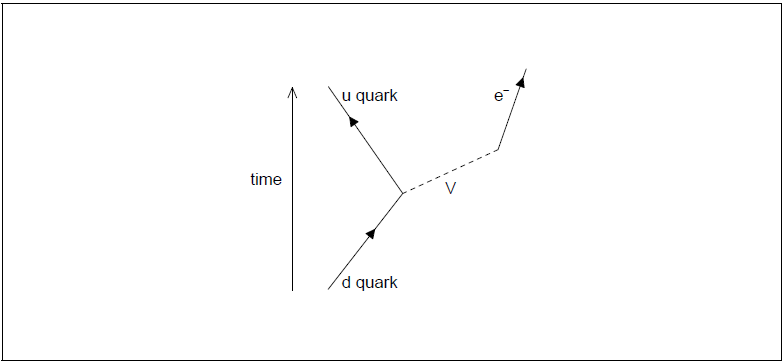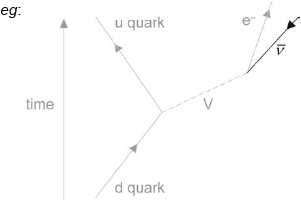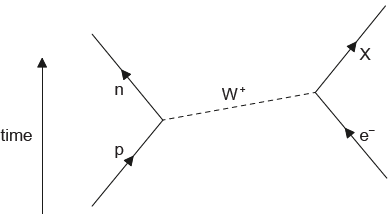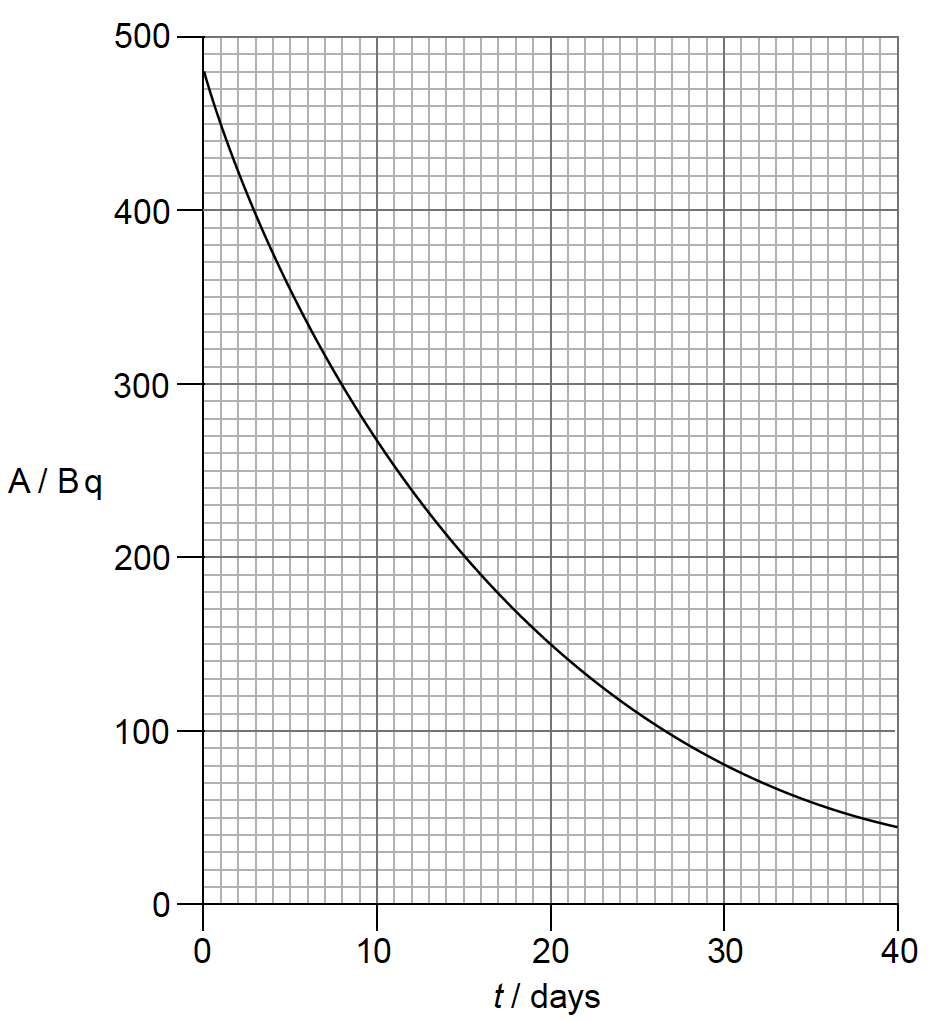IB PHYSICS SL (Standard level)- 2024 – Practice Questions- All Topics
Topic 7.3 – The structure of matter
Topic 7 Weightage : 7%
All Questions for Topic 7.3 – Quarks, leptons and their antiparticles , Hadrons, baryons and mesons , The conservation laws of charge, baryon number, lepton number and strangeness , The nature and range of the strong nuclear force, weak nuclear force and electromagnetic force, Exchange particles, Feynman diagrams, Confinement, The Higgs boson
Rhodium-106 (\(_{\,\,\,45}^{106}{\text{Rh}}\)) decays into palladium-106 (\(_{\,\,\,46}^{106}{\text{Pd}}\)) by beta minus (β–) decay.
The binding energy per nucleon of rhodium is 8.521 MeV and that of palladium is 8.550 MeV.
β– decay is described by the following incomplete Feynman diagram.

a.
Rutherford constructed a model of the atom based on the results of the alpha particle scattering experiment. Describe this model.[2]
State what is meant by the binding energy of a nucleus.[1]
Show that the energy released in the β– decay of rhodium is about 3 MeV.[1]
Draw a labelled arrow to complete the Feynman diagram.[1]
Identify particle V.[1]
▶️Answer/Explanation
Markscheme
a.
«most of» the mass of the atom is confined within a very small volume/nucleus
«all» the positive charge is confined within a very small volume/nucleus
electrons orbit the nucleus «in circular orbits»[2 marks]
the energy needed to separate the nucleons of a nucleus
OR
energy released when a nucleus is formed from its nucleons
Allow neutrons AND protons for nucleons
Don’t allow constituent parts[1 mark]
Q = 106 × 8.550 − 106 × 8.521 = 3.07 «MeV»
«Q ≈ 3 Me V»[1 mark]
line with arrow as shown labelled anti-neutrino/\(\bar v\)
Correct direction of the “arrow” is essential
The line drawn must be “upwards” from the vertex in the time direction i.e. above the horizontal
 [1 mark]
[1 mark]
V = W– [1 mark]
The Feynman diagram shows electron capture.

a.
Deduce that X must be an electron neutrino.[2]
Distinguish between hadrons and leptons.[2]
▶️Answer/Explanation
Markscheme
a.
it has a lepton number of 1 «as lepton number is conserved»
it has a charge of zero/is neutral «as charge is conserved»
OR
it has a baryon number of 0 «as baryon number is conserved»
Do not credit answers referring to energy
hadrons experience strong force
OR
leptons do not experience the strong force
hadrons made of quarks/not fundamental
OR
leptons are not made of quarks/are fundamental
hadrons decay «eventually» into protons
OR
leptons do not decay into protons
Accept leptons experience the weak force
Allow “interaction” for “force”
A nucleus of phosphorus-32 \(\left( {{}_{15}^{32}{\rm{P}}} \right)\) decays by beta minus (β−) decay into a nucleus of sulfur-32 \(\left( {{}_{16}^{32}{\rm{S}}} \right)\). The binding energy per nucleon of \({{}_{15}^{32}{\rm{P}}}\) is 8.398 MeV and for \({{}_{16}^{32}{\rm{S}}}\) it is 8.450 MeV.
a.
Determine the energy released in this decay.[2]
The graph shows the variation with time t of the activity A of a sample containing phosphorus-32 \(\left( {{}_{15}^{32}{\rm{P}}} \right)\).

Determine the half-life of \({{}_{15}^{32}{\rm{P}}}\).[1]
Quarks were hypothesized long before their existence was experimentally verified. Discuss the reasons why physicists developed a theory that involved quarks.[3]
▶️Answer/Explanation
Markscheme
a.
«energy/mass difference =» 8.450 – 8.398 «= 0.052 MeV»
Q = 1.7 or 1.66 or 1.664 MeV
OR
2.66 × 10–13 J
quark theory is simpler OR Occam’s razor example OR simple model explains complex observations
quotes experiment that led to quark theory, eg deep inelastic scattering or electron scattering
model incorporates strong/weak interactions/forces between protons and neutrons
model incorporates conservation rules
model explains differences between neutrons and protons OR explains decay of neutron to proton
